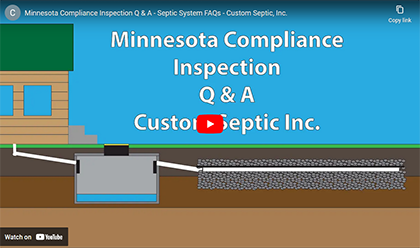 Well-designed and properly installed septic systems are critical to treating wastewater and protecting Minnesota’s surface and groundwater from contamination. Designers must carefully evaluate soil conditions and proximity to groundwater and create systems to function properly on specific sites. For example, designers may choose trench, bed, at-grade, or mound-style drain fields, depending on site conditions.
Well-designed and properly installed septic systems are critical to treating wastewater and protecting Minnesota’s surface and groundwater from contamination. Designers must carefully evaluate soil conditions and proximity to groundwater and create systems to function properly on specific sites. For example, designers may choose trench, bed, at-grade, or mound-style drain fields, depending on site conditions.
Septic systems in Minnesota are governed by a combination of state regulations, local government ordinances, and food/beverage/lodging establishment requirements. The technical criteria and inspection requirements for subsurface sewage treatment systems are governed by Minn. Rules Chapter 7080 and 7081.
Gravity Septic Systems
A gravity septic system, commonly referred to as a conventional or in-ground system, consists of a septic tank and a gravity-flow trench drain field system. Solids in the wastewater are separated in the septic tank. Gravity then causes the gray water to flow into a distribution box or a series of drop boxes which distributes the gray water into the trenches. Once one trench is full, the gray water overflows into the next trench in line.
Pressurized Bed Septic Systems
Pressurized systems are used when soils are suitable for an in-ground system, but gravity flow cannot be achieved due to elevations or other site restrictions. These systems utilize a pump and a separate tank after the septic tank to dose the liquid waste to a drain field. When the pump turns on, the lateral system is pressurized, dispersing the liquid waste evenly throughout the drain field area.
Sand Filter Septic System
A sand filter septic system is a solution when the location and soil conditions are not suitable for a conventional sewage system. This type of system includes not only a pump but also a sand filter that allows extra treatment of the wastewater. This is an extra step (pretreatment) that treats the wastewater before it flows into the drain field.
Mound Septic Systems
A mound septic system is an option when the conditions of soil will not allow for a standard drain field, either the soil coverage is too thin, too dense, or cannot properly filter the amount of water needing to flow through the system. With this type of design, the mound is a hill created above ground level, in a designated area, that is packed with gravel and sand to filter the wastewater once more.
Professional Septic Design And Installation Services
There are a lot of different aspects that need to be determined for proper compliance and operation. Call Custom Septic Inc., at (763) 218-4769 or fill out our Online Request Form. Our professionals have the knowledge, tools, and experience to ensure the correct sewage treatment system is installed based on your needs and location.

 Now Accepting Major Credit Cards!
Now Accepting Major Credit Cards!
